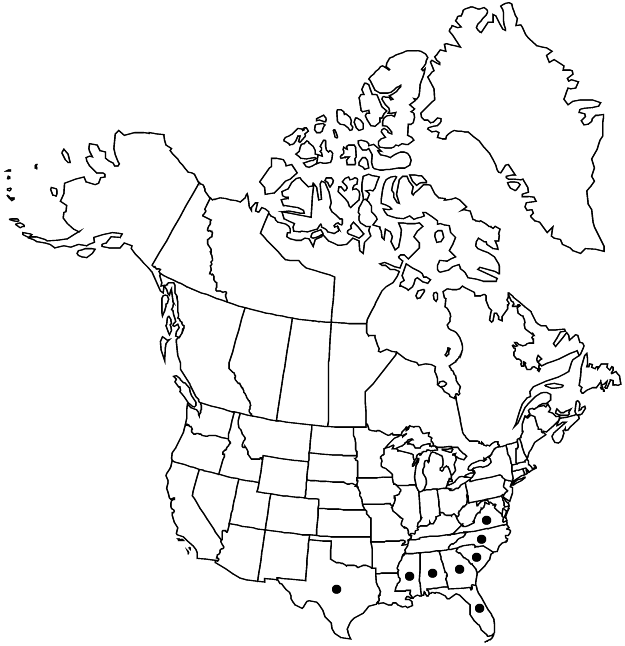Difference between revisions of "Polygonella polygama"
Boston J. Nat. Hist. 5: 231. 1845.
FNA>Volume Importer |
RevisionBot (talk | contribs) m (Bot: Adding category Revised Since Print) |
||
| (8 intermediate revisions by 3 users not shown) | |||
| Line 8: | Line 8: | ||
}} | }} | ||
|common_names=October-flower | |common_names=October-flower | ||
| − | |basionyms={{Treatment/ID/ | + | |special_status={{Treatment/ID/Special_status |
| + | |code=E | ||
| + | |label=Endemic | ||
| + | }} | ||
| + | |basionyms={{Treatment/ID/Basionym | ||
|name=Polygonum polygamum | |name=Polygonum polygamum | ||
|authority=Ventenat | |authority=Ventenat | ||
| + | |rank=species | ||
| + | |publication_title=Descr. Pl. Nouv., | ||
| + | |publication_place=65. 1800 | ||
}} | }} | ||
|synonyms= | |synonyms= | ||
| Line 23: | Line 30: | ||
-->{{Treatment/Body | -->{{Treatment/Body | ||
| − | |distribution= | + | |distribution=Ala.;Fla.;Ga.;Miss.;N.C.;S.C.;Tex.;Va. |
|discussion=<p>Varieties 3 (3 in the flora).</p><!-- | |discussion=<p>Varieties 3 (3 in the flora).</p><!-- | ||
| − | --><p>J. H. Horton (1963) found considerable intergradation among characters used by J. K. Small (1933) to separate Polyonella polygama, P. brachystachya, and P. croomii. He included the latter two taxa in P. polygama. R. P. Wunderlin (1981) as well as G. L. Nesom and V. M. Bates (1984) discussed morphological variation among these geographically distinct entities and recognized three varieties.</p> | + | --><p>J. H. Horton (1963) found considerable intergradation among characters used by J. K. Small (1933) to separate Polyonella polygama, P. brachystachya, and P. croomii. He included the latter two taxa in <i>P. polygama</i>. R. P. Wunderlin (1981) as well as G. L. Nesom and V. M. Bates (1984) discussed morphological variation among these geographically distinct entities and recognized three varieties.</p> |
|tables= | |tables= | ||
|references= | |references= | ||
| Line 56: | Line 63: | ||
-->{{#Taxon: | -->{{#Taxon: | ||
name=Polygonella polygama | name=Polygonella polygama | ||
| − | |||
|authority=(Ventenat) Engelmann & A. Gray | |authority=(Ventenat) Engelmann & A. Gray | ||
|rank=species | |rank=species | ||
| Line 63: | Line 69: | ||
|basionyms=Polygonum polygamum | |basionyms=Polygonum polygamum | ||
|family=Polygonaceae | |family=Polygonaceae | ||
| − | |distribution= | + | |distribution=Ala.;Fla.;Ga.;Miss.;N.C.;S.C.;Tex.;Va. |
|reference=None | |reference=None | ||
|publication title=Boston J. Nat. Hist. | |publication title=Boston J. Nat. Hist. | ||
|publication year=1845 | |publication year=1845 | ||
| − | |special status= | + | |special status=Endemic |
| − | |source xml=https:// | + | |source xml=https://bitbucket.org/aafc-mbb/fna-data-curation/src/2e0870ddd59836b60bcf96646a41e87ea5a5943a/coarse_grained_fna_xml/V5/V5_1099.xml |
|subfamily=Polygonaceae subfam. Polygonoideae | |subfamily=Polygonaceae subfam. Polygonoideae | ||
|genus=Polygonella | |genus=Polygonella | ||
| Line 74: | Line 80: | ||
}}<!-- | }}<!-- | ||
| − | -->[[Category:Treatment]][[Category:Polygonella]] | + | --> |
| + | |||
| + | [[Category:Treatment]] | ||
| + | [[Category:Polygonella]] | ||
| + | [[Category:Revised Since Print]] | ||
Latest revision as of 18:05, 6 November 2020
Subshrubs, perennial, dioecious, 1.5–7 dm. Stems erect or decumbent, usually branched proximally and distally, glabrous or minutely pubescent. Leaves persistent; ocrea margins not ciliate; blade linear to narrowly clavate or broadly spatulate, (3–)4–16(–36) × (0.3–)0.6–3.6(–5) mm, base barely tapered to attenuate, margins hyaline at least along distal 1/2, apex obtuse, glabrous. Inflorescences (2–)4–20(–33) mm; ocreola encircling rachis, only the base adnate to rachis, apex acute to acuminate. Pedicels spreading in anthesis, spreading to reflexed in fruit, 0.2–0.9 mm, as long or much longer than subtending ocreola. Flowers functionally unisexual; filaments dimorphic; anthers pink, orange, or yellow; styles and stigma ca. 0.1 mm in anthesis. Staminate flowers: outer tepals loosely appressed in anthesis, reflexed in fruit, white, broadly elliptic, 0.9–1.8 mm in anthesis, margins entire; inner tepals appressed in anthesis and fruit, white, elliptic, 0.9–1.7 mm in anthesis, margins entire. Pistillate flowers: outer tepals loosely appressed in anthesis, usually reflexed in fruit, white to pink, often drying yellow, broadly elliptic to ovate, 0.5–1.3 mm in anthesis, margins entire; inner tepals appressed in anthesis and fruit, white to pink, often drying yellow or red, broadly elliptic to ovate, 0.6–1.5 mm in anthesis, margins entire. Achenes mostly included, brown to yellow-brown, 3-gonous, 1.3–2.1 × 0.7–1.2 mm, shiny, smooth. 2n = 28.
Distribution

Ala., Fla., Ga., Miss., N.C., S.C., Tex., Va.
Discussion
Varieties 3 (3 in the flora).
J. H. Horton (1963) found considerable intergradation among characters used by J. K. Small (1933) to separate Polyonella polygama, P. brachystachya, and P. croomii. He included the latter two taxa in P. polygama. R. P. Wunderlin (1981) as well as G. L. Nesom and V. M. Bates (1984) discussed morphological variation among these geographically distinct entities and recognized three varieties.
Selected References
None.
Lower Taxa
Key
| 1 | Ocreae with apex acuminate, tip 1-1.5 mm; leaf blades usually 0.5-1 mm wide | Polygonella polygama var. croomii |
| 1 | Ocreae with apex obtuse to acute, tip 0.1-0.5 mm; leaf blades 0.5-6 mm wide | > 2 |
| 2 | Leaf blades 0.5-1 mm wide | Polygonella polygama var. brachystachya |
| 2 | Leaf blades (2-)3-6 mm wide | Polygonella polygama var. polygama |